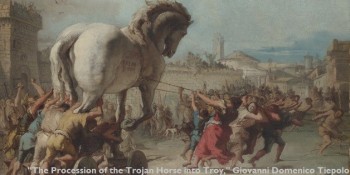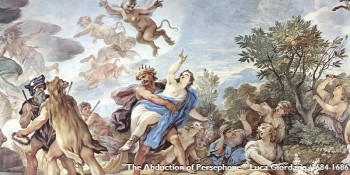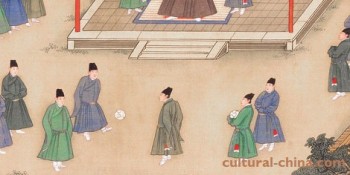Ask anyone who knows me and they’ll tell you I love to use folk sayings at every opportunity. The more, the merrier. Cliches are cliche for a reason, and that’s because good metaphors are like a diligent brain gardener … er … that is, they plant the idea right in your head and give you the context needed for an otherwise potentially obtuse statement. But some metaphors (Greek metaphora, “carry across”) have been around a long time, and the original meanings have been all but lost in favor of the ideas they represent. Here are a few that you may or may not know, arranged by some obscure categorical formula that I came up with myself!
Disclaimer! Folky stuff is not super well-cataloged and tends to be tricky to pin down. Some of these origins might be more recent urban legend than truth. For example, try to look up where the phrase “cold enough to freeze the balls off a brass monkey” comes from.
Bible and ancient times
Doubting Thomas: In John 20:24-27, Thomas is the disciple who doesn’t believe all the others that Jesus came back from the dead, until Jesus shows up and is like, “Hey man, feel my wound-places.”
Good Samaritan: In Luke 10:29-37, Jesus tells the parable of a Jewish guy who gets robbed and beaten up, and the only person who would help him was a Samaritan (Hebrew Samerim, “guardians of the Torah”), a caste of Hebrews who were culturally opposed to the Jews in a manner similar to Protestants and Catholics in Elizabethan times. Bad blood. Of course, if you help somebody on the street today until the ambulance gets there, chances are you won’t be racial enemies with the person you’re helping.
Knock on wood: That’s where the Celtic forest spirits live. In the trees. They can help, maybe, or at least not specifically interfere with your intentions.
Scapegoat: In Leviticus 16:7-10, one goat was sacrificed and another, named Azazel (possibly Hebrew for “goat that departs” or “escape goat”), was used to transfer the people’s sins upon, and it was subsequently driven into the wilderness.
Achilles heel: In Homer’s Iliad, the mortal son of Athena, Achilles, was dipped in a pool of invulnerability water by his heel. Later, during the battle of Troy, Paris managed to shoot him there with a poison arrow to kill him. You all know this one.
Extra mile: In Matthew 5:41, Jesus tells people that if a soldier presses you to carry his crap for a mile (which was permissible under the law), you should take it an extra mile for him.
Farm and market
Fly off the handle: A loose and poorly tended ax head might fly off the handle when used.
Close but no cigar: Cigars were used as carnival prizes in the 19th century. Fun for kids of all ages!
Gift horse in the mouth/From the horse’s mouth: You can tell a horse’s age by its teeth. So while you shouldn’t insult a horse-giver (hence, “gift” horse) by checking out its teeth, you definitely should get the scoop before buying one from a disreputable horse dealer.
Down to brass tacks: A draper might use nose-to arm-length as a rough measure for cloth. You could ask them to get out the brass tacks for more precise cuts.
Cat out of the bag: Some shady people might try to sell you a bag of piglets but hide cats in there instead. If a cat gets out, then you know what’s up.
Dyed in the wool: Wool dyed before it is woven keeps color better than afterward, when it would be dyed “in the piece.”
Go to pot: Animals that outlive their usefulness (via age or stubbornness) go in the pot. To become dinner.
Peeping Tom: An anecdote about Coventry states that while under heavy tax, the governor Leofric’s wife Godiva said “Enough.” He told her he would relent if she went naked through the streets, and she called his bluff. Everybody stayed indoors except some tailor named Tom, who peeped out a window and was struck blind (by God, presumably) for his trouble.
Soldiers and sailors
Cut the mustard: You can cut out having to stand a formal troop assembly, or muster, if your unit is just that awesome all the time. Alternatively, this one might just infer that mustard is awesome.
Know the ropes: If you’re a sailor, you need to know the ropes, or you don’t sail so good.
Cut and run: When sailing, you might cut anchor in an emergency instead of taking the time to haul it back on board.
Flying colors/True colors: “Colors” means flags on a ship. You might proudly fly your colors to port after a victorious battle, and it wasn’t uncommon for ships to display false colors to confuse or fool other ships for various reasons, piratical or otherwise.
Heart on your sleeve: Medieval knights might have worn a token from their lady visible on the sleeve of their armor during a competition or battle.
Bite the bullet: Before anesthetics, biting something helped to shut out the pain of emergency surgery. In a war situation, bullets might be closest to hand for biting.
Sporting and bragging
Chip on your shoulder: In a boys’ dueling convention, circa 1830 New York, a chip was placed on one’s shoulder to instigate the other boy to knock it off and thus start a fight.
Drop of a hat: Some competitions started when the officiant waved his hat downward.
Beating around the bush: An indirect hunting method used to chase the birds out of the bush, where they could be shot by another party.
Break a leg: Yiddish hatslokhe un brokhe (“success and blessing”), awkwardly misinterpreted to German hals und beinbruch (“neck and leg break”), maybe? No other ready origin presents itself.
Pass the buck: You might have used a knife with a buckhorn handle as a poker marker to keep track of who’s dealing.
Hat trick: A cricket bowler, circa 1877, who took three wickets was given a new hat, or was allowed to pass his hat around for collection, by his cricket club.
Lily livered: White colored ichor from your liver meant you were bloodless and, therefore, cowardly.
Hands down: A horse jockey firmly in the lead can put his hands down as he approaches the finish line.
Misplaced meanings
Dog days of summer: Sirius (the dog star) rises and sets with the sun in early July through early September.
Kick the bucket: When slaughtering a pig, you might tie its legs to a wooden beam (French buquet), which it kicks while dying.
Scot free: “Scot” is an Old Norse word (skot) for a local tax.
Spitting image: Spit and image, as in “all the substance”: you’re made of your parents’ spit and look like them, too.
Under the weather: If you can’t stand up straight against the wind, due to being ill or drunk, you are under it.
Blue blood: In the middle ages, Spanish aristocracy had pale skin, so you could see their veins, as opposed to the Arab lower class.
Good-bye: “God be with ye.” I know, right?
Hoist by own petard: Coined by Shakespeare in Hamlet, a petard was a container of gunpowder with a fuse. If it exploded prematurely, it might hoist you into the air, quite fatally.
Pull out all the stops: To help the air flow through a church organ, you need to clean the stops by pulling debris out of them.
Hopefully you’ve enjoyed this little foray into folk wisdom as much as I have. Don’t miss the forest for the trees, now!
Sources include:









